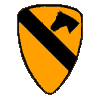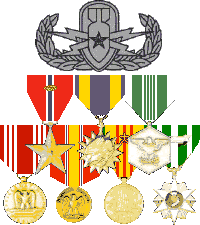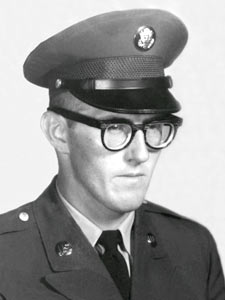Frederick Phillip SmithCaptainHQ CO, 1ST CAVALRY DIVISION (AIRMOBILE), USARV Army of the United States 06 March 1946 - 13 February 1971 Oklahoma City, Oklahoma Panel 05W Line 102 |


| |
  
|

|
The database page for Frederick Phillip Smith
|
At the time of his death, on February 13, 1971, Captain Frederick Phillip "Fred" Smith was the Assistant Division Chemical Officer assigned to Headquarters & Headquarters Company, 1st Cavalry Division (Airmobile), United States Army, Pacific - Republic of Vietnam. He was stationed at Phuoc Vinh, Camp Casey, Republic of South Vietnam. Captain Smith arrived in Vietnam on March 23, 1970 and was assigned as the Chemical Officer, Headquarters & Headquarters Company, 2d Brigade, 1st Cavalry Division (Airmobile). On July 9, 1970 he was reassigned as the Assistant S-3, HHC, 2d Brigade, 1st Cavalry Division (Airmobile). On October 10, 1970, the Captain was again reassigned as the Assistant Division Chemical Officer, Headquarters & Headquarters Company, 1st Cavalry Division (Airmobile). On February 13, 1971, Captain Smith was conducting a "People Sniffer" mission over Binh Tuy Province, III Corps (present-day Binh Thuan Province) in a valley suspected to be occupied by enemy troops at Military grid coordinates YS848912. Headquarters, Headquarters Battery, 2d Battalion, 20th Artillery (aerial rocket), 1st Cavalry Division (Airmobile) was tasked to support the mission. The mission team consisted of one Army UH-1H Huey helicopter (68-16360) and two AH-1G Cobra attack helicopters to provide cover fire. Lieutenant Colonel Adalbert E. "Bert" Toepel, Jr., 2d Battalion's commanding officer, sat in the Huey's front left seat as the aircraft commander. In the front right seat sat the pilot, Captain L. R. Burnette. The crew engineer (or crew chief) in the far left well was Specialist Fourth Class T. M. Morgan. Private First Class W. Wallace was the gunner in the far right well. Besides Captain Smith, others on the flight included 2d Battalion's Sergeant Major, Sergeant Major Dobson, and an enlisted soldier from the 184th Chemical Platoon (Direct Support) who was there to assist Captain Smith with the drop. The mission's objective was to make one or two runs at 1,500 feet (optimum altitude for maximum effect) down the valley dropping approximately 20 modified Air Force BLU E158 tactical CS-2 (2-chlorobenzalmalononitrile) clusters bombs from the Huey helicopter. CS is a chemical agent in the family of riot control agents, commonly called "tear gas." Each E158 cluster bomb consisted of 264 D-cell battery-sized canisters of CS held in place by a plastic unit that measures 3 feet long and 1 foot wide. A timing fuse detonates a bursting/igniting charge that sends the smaller munitions over a 50-meter area, spraying CS as they scatter. The hope was that the tear gas submunitions would drive the enemy from their hiding places and expose them in a more open area making them vulnerable to ground artillery fire. The drop time was in early morning to assure that the CS gas would settle into the jungle canopy instead of being blown away by the wind, which was expected to happen later in the day. Take off was scheduled for 0600 hours. No problems were encountered in the preparations and loading of the canisters, which were placed on end just inside the open doors of the helicopter's cargo compartment. As a safety precaution, the pilot of the helicopter (right seat) wore a protective mask in the event any of the CS gas entered the crew compartment and adversely affected either of the pilots. It is not recalled if anybody else was wearing a protective mask during the mission. All passengers were seat-belted in. Upon the start of their run, there was a sudden explosion in the passenger/cargo compartment and the entire interior was immediately filled with burning CS gas. Somehow the arming wires must have come loose, and an E158 cluster began detonating inside the Huey helicopter. It's surmised that the cause of the malfunction was that someone somehow accidentally snagged the arming wire, which activated the timer. The copper retaining wires on the fuzes had been precut. Everyone without a protective mask was suddenly blinded. Prior to the mission, a gallon can of transmission fluid was placed in the cargo compartment. After the clusters went off the crew chief announced over the intercom, "Sir, the transmission fluid is on fire!" The pilot immediately went into autorotation in order to get the helicopter closer to the ground and the crew prepared for a possible emergency landing in the 100-foot plus high jungle canopy. The aircraft commander instructed the crew in the cargo compartment to jettison all canisters, which the aircraft commander now believes had already happened. In avoiding the conflagration in the cargo compartment someone somersaulted onto the radio console, located between the two pilots. The aircraft commander wrestled with that person briefly to remove him from the proximity of the helicopter's controls. The aircraft commander instructed the pilot to check his instruments and the pilot reported that they still had power. Now realizing that there wasn't a fire on board, but there was a lot of CS gas and smoke, the aircraft commander jettisoned his aircraft entry door. With his sight now returning, the aircraft commander took control of the helicopter from the pilot and flew in a slip (sideways), which caused air to blow across the interior of the helicopter and helped evacuate the gas fumes. While this was going on, Captain Smith, although badly burned and with his clothing on fire from the black powder bursting charges, was able to undo his seatbelt and push all of the clusters out of the helicopter. In the confusion, and blinded by the CS smoke, he may have been thrown out during the autorotation. Captain Smith went out with the cluster munitions and fell 1,500 feet to his death. When their vision returned, someone reported that Captain Smith was missing. What was originally thought to be a burning can of transmission fluid turned out to be the burning of a small container of CS gas on the floor of the helicopter. The small containers of burning gas caused extensive damage to the nylon seats and interior insulation in the helicopter. Captain Smith's quick thinking and actions saved the lives of six people onboard the Huey helicopter. Not knowing what damage may have occurred to the aircraft, the helicopter was flown to a nearby artillery firebase where it landed. The accompanying escort helicopters followed them. The incident was then reported to the division tactical operations center. Three days later an infantry unit was able to go in and recover Captain Smith's body.
From a comrade-in-arms, |
|
Top of Page
www.VirtualWall.org Back to |
With all respect
Jim Schueckler, former CW2, US Army
Ken Davis, Commander, United States Navy (Ret)
Memorial first published on 22 May 2008
Last updated 08/10/2009